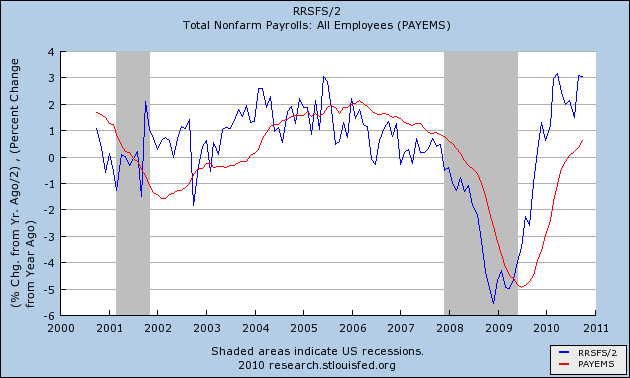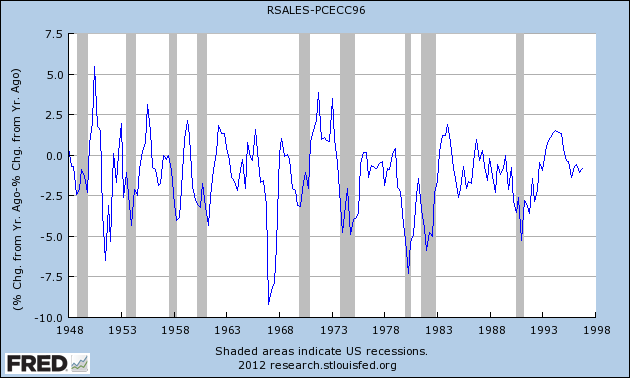This week I want to revisit and update my forecast from the beginning of the year. That forecast boiled down to softness in the first half, possibly including one quarter of negative GDP but escaping a recession, and a stronger second half. Since that time I've written a number of posts considering ECRI's recession call, trying to understand their argument while at the same time noting the wealth of contrary data. Since I don't get to write the headline when my blog posts are republished elsewhere, let me be clear about my current thinking as to ECRI's calls. That is:
1. their original call for a recession by the end of 2011 was wrong. Period. Doubters need to go back and listen to the September interview on CNBC where Lakshman Achuthan was very explicit that the recession would start no later than the next quarter, i.e., 4Q 2011.
2. the jury is out on their revised recession call of recession by the end of 2Q 2012 (although the data continues to tilt away from that view).
3. the original explanation for the revised recession call, made in a series of interviews a few weeks ago, was pathetically lame. The updated explanation last week, which seems to be a direct response to my recent post, was more nuanced and explanatory.
It'll take a number of posts to state my forecast more thoroughly, but today let me address one point. The best bearish case rests on a weakened consumer whose wages have not kept up with inflation, who is now being battered by yet another spike in the price of gasoline. This is an extremely reasonable point, and appears to underlay ECRI's position, which is that economies don't "muddle along" at sub-2% growth. If an economy decelerates under 2% YoY growth, a recession soon follows. Sputtering real personal consumption expenditures show that the economy is now slowing down into reversal.
As it happens, there is a very important contrary example to the sub-2% thesis, but I'll get to that in another post. In the meantime, let's look at real PCE's. First of all, here's a graph that appeared on Business Insider as the graph that makes ECRI scream recession:

PCE's certainly are very weakly positive YoY at this point. The graph suggests that nonfarm payrolls will follow on a YoY basis.
The problem is, real retail sales also lead nonfarm payrolls . Take the YoY% change in real retail sales, divide by two, and you usually come pretty close to the YoY% change in nonfarm payrolls about 6 or so months later, as shown for the last 10+ years in this graph:

Retail sales constitute about 50% of PCE's. It should be no surprise, then, that the two make peaks and troughs simultaneously:

Note, however, that real retail sales are much more volatile. And, as this graph below (subtracting YoY PCE growth from YoY real retail sales growth through 1997) shows, in a very specific and non-random way:

Note that early in economic expansions, YoY real retail sales growth far outstrips YoY PCE growth. As the economy wanes into contraction, YoY real retail sales grow less and ultimately contract more than YoY PCE's. You can see that by noting that retail sales minus PCE's are always negative BEFORE the economy ever tips into recession. That's 11 of 11 times. Further, in 10 of those 11 times (1957 being the noteworthy exception), the number was not just negative, but was continuing to decline for a significant period before we tipped into recession. This makes perfect sense, as retail sales generally include many far more discretionary purchases. As the economy accelerates, consumers make more discretionary purchases. As it slows, the more discretionary retail purchases are the first things cut.
So what does that relationship show now? Since you know I'm a smarta$$ and I'm saving a surprise for last, here's the graph up through the most recent data:

Not only is the relationship not negative, not only is it stable for the last few months, but it remains at a level of positivity that has only been exceeded four times in the last 60+ years (once in the 1940s, once in the 1950s, and twice in the early 1970s).
Despite the perfectly rational bearish argument cited above, the facts on the ground are that consumers are not cutting back on discretionary purchases to preserve other spending. Until they do, consumer spending does not support any claim that a recession has begun or is even imminent.